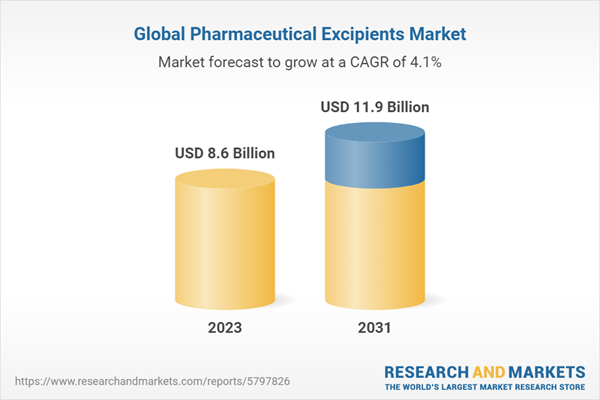Pharmaceutical Excipients: Introduction
Pharmaceutical excipients are inert substances used in the formulation of drugs. They play a crucial role in drug delivery, stability, and overall effectiveness by facilitating drug absorption, enhancing solubility, and improving taste, texture, and appearance. Excipients are used in various dosage forms, including tablets, capsules, liquids, and injectables. Commonly used excipients include binders, fillers, disintegrants, lubricants, coatings, preservatives, and solvents.The global pharmaceutical excipients market has been experiencing significant growth due to factors such as the expanding pharmaceutical industry, increasing demand for generic drugs, and advancements in drug delivery systems. Moreover, the rising prevalence of chronic diseases and the growing focus on biopharmaceuticals contribute to market growth.
Pharmaceutical Excipients Market Scenario
The global pharmaceutical excipients market is poised for significant growth as the demand for pharmaceutical products continues to rise. Factors such as the expanding pharmaceutical industry, increasing demand for generic drugs, and advancements in drug delivery systems contribute to the market's expansion. The market is characterized by regional dynamics shaped by pharmaceutical infrastructure, government support, and investment in research and development. However, challenges such as regulatory hurdles, the need for high-quality excipients, and supply chain complexities may impact market growth.North America: The largest market for pharmaceutical excipients, driven by factors such as advanced pharmaceutical infrastructure, the presence of major pharmaceutical companies, and a robust research and development landscape.
Europe: The second-largest market, with increasing demand for excipients due to a growing elderly population, government support, and an expanding pharmaceutical sector.
Asia-Pacific: Expected to witness the highest growth rate due to factors such as a rapidly growing population, increasing prevalence of chronic diseases, and growing investments in pharmaceutical infrastructure and research.
Pharmaceutical Excipients Market Segmentations
Market Breakup by Product Type
Polymers
- MCC
- HPMC
- Ethyl Cellulose
- Methyl Cellulose
- CMC
- Croscarmellose Sodium
- Povidone
- Pregelatinized starch
- Sodium starch glycolate
- Polyethylene Glycol
- Acrylic Polymers
Alcohols
- Glycerin
- Propylene Glycol
- Sorbitol
- Mannitol
- Others
Sugars
- Lactose
- Sucrose
- Others
Minerals
- Calcium Phosphate
- Calcium Carbonate
- Calcium Sulfate
- Clay
- Silicon Dioxide
- Titanium Dioxide
- Others
- Gelatins
- Others
Market Breakup by Functionality
Binders and Adhesives
- Organic
- Inorganic
Disintegrants
- Organic
- Inorganic
Coating Material
- Organic
- Inorganic
Colouring Agents
- Organic
- Inorganic
Solubilizers
- Organic
- Inorganic
Flavours
- Organic
- Inorganic
Sweetening Agents
- Organic
- Inorganic
Diluents
- Organic
- Inorganic
Lubricants
- Organic
- Inorganic
Buffers
- Organic
- Inorganic
Emulsifying Agents
- Organic
- Inorganic
Preservatives
- Organic
- Inorganic
Antioxidants
- Organic
- Inorganic
Sorbents
- Organic
- Inorganic
Solvents
- Organic
- Inorganic
Emollients
- Organic
- Inorganic
Glidants
- Organic
- Inorganic
Chelating Agents
- Organic
- Inorganic
Antifoaming Agents
- Organic
- Inorganic
- Others
Market Breakup by End User
- Pharmaceutical and Biopharmaceutical Companies
- Contract Formulators
- Research Organization and Academics
- Others
Market by Distribution Channel
- Direct Tender
- Retail Sales
- E-Commerce
- Others
Market Breakup by Region
North America
- United States of America
- Canada
Europe
- United Kingdom
- Germany
- France
- Italy
- Others
Asia Pacific
- China
- Japan
- India
- ASEAN
- Australia
- Others
Latin America
- Brazil
- Argentina
- Mexico
- Others
Middle East and Africa
- Saudi Arabia
- United Arab Emirates
- Nigeria
- South Africa
- Others
Key Trends in the Global Pharmaceutical Excipients Market
Some key trends of the market are as follows:- Growing demand for generic drugs: With the increasing need for affordable medication, the demand for generic drugs is rising, driving the demand for pharmaceutical excipients
- Technological advancements: Innovations in drug delivery systems, such as nanotechnology and targeted drug delivery, are fostering the development of novel excipients
- Expansion of the pharmaceutical industry: The growing pharmaceutical industry, particularly in emerging markets, is propelling the demand for excipients
Competitor Landscape
The key features of the market report include patent analysis, grants analysis, clinical trials analysis, funding and investment analysis, partnerships, and collaborations analysis by the leading key players. The major companies in the market are as follows:- Kerry Group plc
- DFE Pharma
- Cargill
- Incorporated
- Pfanstiehl
- Colorcon
- MEGGLE GmbH & Co. KG
- Roquette Frères
- The Lubrizol Corporation
- BASF SE
- Avantor Inc
- BENEO
- Chemie Trade
Table of Contents
Companies Mentioned
- Kerry Group plc.
- Dfe Pharma
- Cargill
- Incorporated
- Pfanstiehl
- Colorcon
- Meggle GmbH & Co. Kg
- Roquette Frères
- The Lubrizol Corporation
- Basf Se
- Avantor Inc.
- Beneo
- Chemie Trade
Table Information
| Report Attribute | Details |
|---|---|
| No. of Pages | 147 |
| Published | May 2023 |
| Forecast Period | 2023 - 2031 |
| Estimated Market Value ( USD | $ 8.6 Billion |
| Forecasted Market Value ( USD | $ 11.9 Billion |
| Compound Annual Growth Rate | 4.1% |
| Regions Covered | Global |
| No. of Companies Mentioned | 13 |









